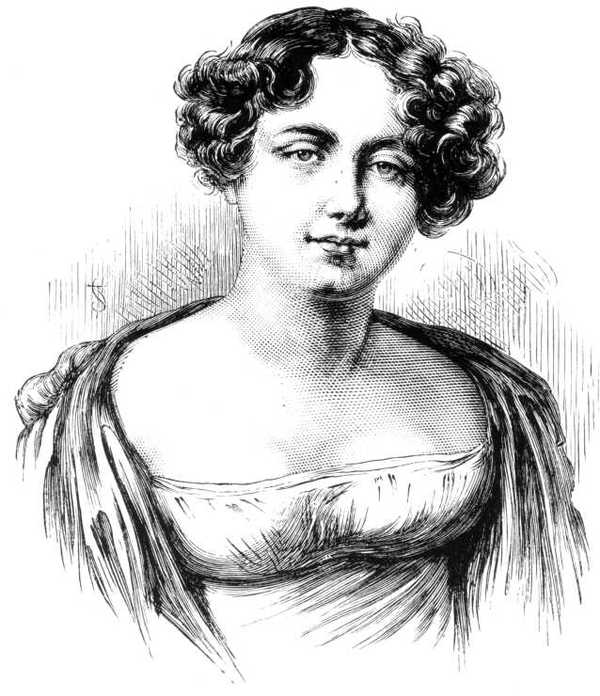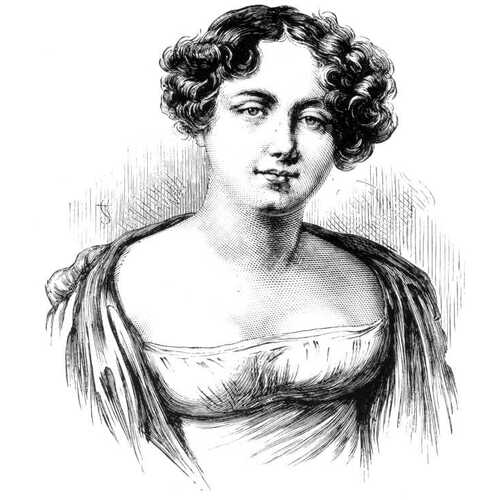
Source: Courtesy of Wikimedia Commons
GRIFFIN, JANE (Franklin, Lady Franklin), world traveller, organizer of Arctic expeditions; b. 1792 in London, one of three daughters of John Griffin and Mary Guillemard, both of Huguenot stock; d. 18 July 1875 at London.
Jane Griffin was educated at home and at a small boarding school in Chelsea. She was a close friend of the poetess, Eleanor Anne Porden, first wife of John Franklin*, who died in 1825, only six days after Franklin had left England on his second Arctic overland expedition. When Franklin returned in 1827, he renewed his acquaintance with the Griffin family and in November 1828 he and Jane were quietly married. Five months later he was knighted.
During her youth, Jane had travelled throughout Britain and had frequently visited the Continent with her widowed father, a wealthy silk weaver, and with her sisters or friends. Now, as Lady Franklin, she continued to travel and to describe the events of a crowded life in voluminous journals and long letters. Between 1830 and 1833, when Franklin had command of a frigate on the Mediterranean station, she visited many parts of North Africa, Syria, and Asia Minor. From 1836 to 1843, when Franklin was lieutenant governor of Van Diemen’s Land (now Tasmania), she toured the island and took a lively interest in promoting the social and cultural life of the young settlement. She is said to have been the first woman to go overland from Melbourne to Sydney, Australia, and she also visited many parts of New Zealand.
On his return to England in 1844, Franklin, despite his age (nearly 60), sought and obtained the command of a naval expedition then being outfitted to find a northwest passage. In May 1845 he sailed with Erebus and Terror, provisioned for three years. When in 1848 no word had been received from the expedition, five relief and searching expeditions were sent out. Other expeditions followed every year until 1854, when Dr John Rae* learned from Eskimos near King William Island details of the expedition’s tragic fate.
Lady Franklin took a leading part in the organization of the searching expeditions. Between 1850 and 1857 she outfitted five ships wholly or mainly at her own expense, and she inspired substantial contributions to her cause from other persons and from other nations. This work involved her with many leading personalities of her time and she became as learned in Arctic geography as any authority of the day. By returning again and again to the orders Admiralty had given her husband and to her knowledge of his invincible sense of duty, she was, as events proved, in general more nearly correct about his route and where his ships should be sought than anyone else except, perhaps, Dr Richard King.
In 1857, at personal expense, she sent the yacht Fox (Capt. Francis Leopold McClintock*), in a final search for survivors, records, and other evidences of the expedition’s fate. Three years later M’Clintock returned with numerous relics, among them a record that gave news of the discovery of a northwest passage, of Franklin’s death in 1847 and of other deaths, of the abandonment of the ships in 1848, and of the survivors’ intention to head for Back River, on which journey, as later searches revealed, the last of the men must have died.
Exhausted by the dramatic events of the previous 12 years, Lady Franklin now turned with relief to her passion for foreign travel. She and her secretary-companion, Sophia Cracroft, her niece by marriage, accepted a long-standing invitation to visit Henry Grinnell, a wealthy New York merchant who had personally supported two expeditions in the Franklin search. Lady Franklin had visited North America in 1846, and she was eager to return. In August 1860, after an enthusiastic reception in New York, she and Sophia travelled to Montreal, where their reception was hardly less royal than that accorded the young Prince of Wales, who was then touring the Canadas. They visited Quebec and cruised up the Saguenay River, then stopped at Ottawa, Kingston, Toronto, and Hamilton on their return to New York, where they sailed for San Francisco by way of Cape Horn.
They reached California early in 1861 and pressed northward to British Columbia, reaching Esquimalt on 24 February, delighted, according to Sophia, to be “once more among our own people only, after many months of residence with Americans.” Lady Franklin was more than somewhat anti-American and objected especially to American accents. They spent a month in Victoria, during which they crossed to the mainland to ascend the Fraser River, first by commercial vessel as far as Yale, then in a canoe paddled by 12 Indians up to the Fraser’s first falls. On their return, they discovered hanging over a narrow canyon a white banner with “Lady Franklin Pass” lettered on it, a tribute from the citizens of Yale that has not, as a place-name, endured. After a short return visit to California, they continued their journey by way of the Sandwich Islands (Hawaii), Japan, and India. During the rest of the decade, Lady Franklin frequently visited Europe and made a long tour of India.
In October 1865 she first heard rumours that Charles Francis Hall believed, on the basis of Eskimo reports, that there might still be survivors of Franklin’s expedition. She wished to question him personally and, when she learned in September 1869 that he had come back from King William Island with numerous relics of the expedition, she and Sophia set out, by a circuitous route, to meet him in the United States.
They rounded Cape Horn once more, stopped again at San Francisco, then, in late April 1870, travelled farther north on the steamer Newborn. After a few days among old friends in Victoria, they continued up the west coast to Alaska. On 10 May they stopped at Tongass and two days later reached Sitka, where they spent a month. Sophia’s 16-page letter home and her illustrated journal of their residence in Sitka are a valuable description of Alaska in its first years of occupation by the United States. In July they travelled by rail from San Francisco to Salt Lake City, where they stopped to disapprove of the Mormons on their home ground. Brigham Young himself came to visit them, which prompted Sophia to suppose “it was the first time in his life, that the President [Young] had ever paid a visit of ceremony or respect to any woman.” In Cincinnati, Ohio, and later in New York they achieved the great object of their journey, interviews with Hall. Unfortunately, no record of what passed between them has been preserved. At the time of their meetings, Hall’s plans to try for the North Pole had been formed, but he evidently agreed to renew later his search for survivors on or near King William Island.
Even when she was in her eighties, Lady Franklin’s attention was still firmly fixed on Arctic matters and in 1875 she took an active interest in the preparations of the expedition by George Strong Nares toward the North Pole and, especially, in Allen Young’s proposed search for Franklin’s records. Among her very last concerns was the erection in Westminster Abbey of a monument to her husband, which was unveiled a fortnight after her own death. It bore, in part, these words: “. . . erected by Jane, his widow, who, after long waiting, and sending many in search of him, herself departed, to seek and to find him in the realms of light . . . .” She was buried in Kensal Green, west London, beside her sister, Lady Mary Simpkinson.
Lady Franklin never allowed herself to be photographed, she published no books, she did not lecture, and her campaigns were mainly conducted through others. But, in a period when popular sentiment was greatly influenced by the example of Queen Victoria mourning her consort, Lady Franklin’s steadfast loyalty to her husband’s memory and her own impressive dignity in adversity gave her, despite her reserve, a firm hold on the public’s imagination and sympathy, and her name was a household word throughout the world.
It has often been said that the loss of Franklin’s expedition achieved more for the exploration of the Canadian Arctic than its success could have done. To the extent that this generalization is true, the credit is due to Lady Franklin, who would not rest nor would she let those in authority rest until the whole truth of the expedition’s fate, so far as it could be ascertained, had been found out and the achievements of her husband and his men fittingly acknowledged.
SPRI, ms 248/121, 248/122 (Jane Franklin’s two-volume journal, August–September 1860, 1–5 Jan. 1861); ms 248/160 (Jane Franklin’s journal, July–August 1846); ms 248/163/3 (Jane Franklin’s journal notes, July–August 1860); ms 248/242 (Sophia Cracroft’s journal at Sitka, 12 May–14 June 1870); ms 248/247/73–83 (Sophia Cracroft’s letters, 13 Dec. 1860–9 June 1862); ms 248/247/84–96 (her letters, 23 Jan.–18 July 1870); ms 695 (Sophia Cracroft’s journal letter, February–April 1861).
Times (London), 19 July 1875. DNB. Kathleen Fitzpatrick, Sir John Franklin in Tasmania, 1837–1843 (Melbourne, Aust., 1949). A. L. Korn, The Victorian visitors: an account of the Hawaiian kingdom, 1861–1866, including the journal letters of Sophia Cracroft, extracts from the journals of Lady Franklin, and diaries and letters of Queen Emma of Hawaii (Honolulu, 1958). F. L. M’Clintock, The voyage of the “Fox” in the Arctic seas: a narrative of the discovery of the fate of Sir John Franklin and his companions (London, 1859). W. F. Rawnsley, The life, diaries, and correspondence of Jane, Lady Franklin, 1792–1875 (London, 1923). F. J. Woodward, Portrait of Jane: a life of Lady Franklin (London, 1951).
Cite This Article
Alan Cooke, “GRIFFIN, JANE (Franklin, Lady Franklin),” in Dictionary of Canadian Biography, vol. 10, University of Toronto/Université Laval, 2003–, accessed January 1, 2025, https://www.biographi.ca/en/bio/griffin_jane_10E.html.
The citation above shows the format for footnotes and endnotes according to the Chicago manual of style (16th edition). Information to be used in other citation formats:
| Permalink: | https://www.biographi.ca/en/bio/griffin_jane_10E.html |
| Author of Article: | Alan Cooke |
| Title of Article: | GRIFFIN, JANE (Franklin, Lady Franklin) |
| Publication Name: | Dictionary of Canadian Biography, vol. 10 |
| Publisher: | University of Toronto/Université Laval |
| Year of publication: | 1972 |
| Year of revision: | 1972 |
| Access Date: | January 1, 2025 |



